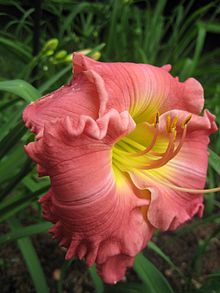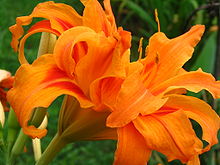- Daylily
-
Daylily 
Scientific classification 
Kingdom: Plantae clade: Angiosperms clade: Monocots Order: Asparagales Family: Xanthorrhoeaceae Subfamily: Hemerocallidoideae Genus: Hemerocallis Species See text.
Daylily is the general nonscientific name of a species, hybrid or cultivar of the genus Hemerocallis (
 /ˌhɛmɨroʊˈkælɪs/).[1] Daylily cultivar flowers are highly diverse in colour and form, as a result of hybridization efforts of gardening enthusiasts and professional horticulturalists. Thousands of registered cultivars are appreciated and studied by local and international Hemerocallis societies.[2] Hemerocallis is now placed in family Xanthorrhoeaceae, subfamily Hemerocallidoideae, and formerly was part of Liliaceae (which includes Lilium, True Lilies).
/ˌhɛmɨroʊˈkælɪs/).[1] Daylily cultivar flowers are highly diverse in colour and form, as a result of hybridization efforts of gardening enthusiasts and professional horticulturalists. Thousands of registered cultivars are appreciated and studied by local and international Hemerocallis societies.[2] Hemerocallis is now placed in family Xanthorrhoeaceae, subfamily Hemerocallidoideae, and formerly was part of Liliaceae (which includes Lilium, True Lilies).Contents
Description
Daylilies at the Block Island resort in Rhode Island.
Daylilies are perennial plants. The name Hemerocallis comes from the Greek words ἡμέρα (hēmera) "day" and καλός (kalos) "beautiful". This name alludes to the attractive flowers of this genus which typically last no more than 24 hours. The flowers of most species open at sunrise and wither at sunset, possibly replaced by another one on the same scape (flower stalk) the next day. Some species are night-blooming. Daylilies are not commonly used as cut flowers for formal flower arranging, yet they make good cut flowers otherwise as new flowers continue to open on cut stems over several days.
Hemerocallis is native to Eurasia, including China, Korea, and Japan, and this genus is popular worldwide because of the showy flowers and hardiness of many kinds. There are over 60,000 registered cultivars. Hundreds of cultivars have fragrant flowers, and more scented cultivars are appearing more frequently in northern hybridization programs. Some cultivars rebloom later in the season, particularly if their capsules, in which seeds are developing, are removed.
Most kinds of Daylilies occur as clumps, each of which has leaves, a crown, flowers, and roots. The long, linear lanceolate leaves are grouped into opposite fans with arching leaves. The crown is the small white portion between the leaves and the roots. Along the scape of some kinds of daylilies, small leafy "proliferations" form at nodes or in bracts. A proliferation forms roots when planted and is often an exact clone of its parent plant. Many kinds of daylilies have thickened roots in which they store food and water.
A normal, single daylily flower has three petals and three sepals, collectively called tepals, each with a midrib in the same or in a contrasting color. The centermost part of the flower, called the throat, usually has a different color than more distal areas of its tepals. Each flower usually has six stamens, each with a two-lobed anther. After successful pollination, a flower forms a capsule (often erroneously called a pod).
The Fulvous Daylily, although a beautiful plant, is an unwanted alien, invasive weed in some parts of the United States, such as in Wisconsin (Wisconsin Department of Natural Resources).[3] People sometimes plant the Fulvous Daylily and other rhizomatous daylilies, which have underground runners. These kinds can overrun one's garden, and can take an appreciable amount of time and effort to confine or remove.
Cultivars
Depending on the species and cultivar, daylilies grow in USDA plant hardiness zones 1 through 11, making daylilies some of the more adaptable landscape plants. Hybridizers have developed the vast majority of cultivars within the last 100 years. The large-flowered, bright yellow Hemerocallis 'Hyperion', introduced in the 1920s, heralded a return to gardens of the once-dismissed daylily, and is still widely available in the nursery trade. Daylily breeding has been a specialty in the United States, where daylily heat- and drought-resistance made them garden standbys since the 1950s. New cultivars have sold for thousands of dollars, but sturdy and prolific introductions sell at reasonable prices of $20 or less.
The Tawny Daylily (Hemerocallis fulva), and the sweet-scented Lemon-lily (H. lilioasphodelus; H. flava, old name) were early imports from England to 17th-century American gardens and soon escaped from gardens. The introduced Tawny Daylily is now common in many natural areas, and some people think that it is a native wildflower. Its nonscientific names include Railroad Daylily and Roadside Daylily and Outhouse Lily, Tiger Lily, and Wash-house Lily (although it is not a true lily). Some people have planted this species near outhouses and wash houses, hence two of its nonscientific names.
Hemerocallis is one of the very highly hybridized plant genera. Hybridizers register hundreds of new cultivars yearly. Hybridizers have extended the genus' color range from the yellow, orange, and pale pink of the species, to vibrant reds, purples, lavenders, greenish tones, near-black, near-white, and more. However, hybridizers have not yet been able to produce a daylily with primarily blue flowers in forms of blue such as azure blue, cobalt blue, and sky blue. Flowers of some cultivars have small areas of cobalt blue.
 The Tawny Daylily (Hemerocallis fulva)
The Tawny Daylily (Hemerocallis fulva)
Other flower traits that hybridizers developed include height, scent, ruffled edges, contrasting "eyes" in the center of a bloom, and an illusion of glitter which is called "diamond dust." Sought-after improvements include foliage color and variegation and plant disease resistance and the ability to form large, neat clumps. Hybridizers also seek to make less-hardy plants hardier in Canada and the Northern United States by crossing evergreen and semi-evergreen plants with those that become dormant and by using other methods. Many kinds of daylilies form clumps of crowded shoots. People dig up such kinds every 3 or so years, separate shoots, and replant only some of the shoots to reduce crowding. This process increases the flowering of many cultivars.
In the last several decades, many hybridizers have focused on breeding tetraploid plants, which tend to have sturdier scapes and tepals than diploids and some flower-color traits that are not found in diploids. Until this trend took root, nearly all daylilies were diploid. "Tets," as they are called by aficionados, have 44 chromosomes, while triploids have 33 chromosomes and diploids have 22 chromosomes per individual plant.[4] Hemerocallis fulva 'Europa', H. fulva 'Kwanso', H. fulva 'Kwanso Variegata', H. fulva 'Kwanso Kaempfer', H. fulva var. maculata, H. fulva var. angustifolia, and H. fulva 'Flore Pleno' are all triplods that almost never produce seeds and reproduce almost solely by underground runners (stolons) and dividing groups by gardeners. A polymerous daylily flower is one with more than three sepals and more than three petals. Although some people synonymize “polymerous” with “double,” some polymerous flowers have over five times the normal number of petals.
Culinary use
The flowers of some species are edible and are used in Chinese cuisine. They are sold (fresh or dried) in Asian markets as gum jum or golden needles (金针 in Chinese; pinyin: jīnzhēn) or yellow flower vegetables (黃花菜 in Chinese; pinyin: huánghuācài). They are used in hot and sour soup, daylily soup (金針花湯), Buddha's delight, and moo shu pork. The young green leaves and the tubers of some (but not all[citation needed]) species are also edible. The plant has also been used for medicinal purposes. Care must be used as some species of lilies can be toxic.
Species
This is a list of species, not of cultivars, which number in the thousands:
- Hemerocallis altissima Stout
- Hemerocallis aurantiaca Baker
- Hemerocallis citrina Baroni
- Hemerocallis cordata C.P.Thunberg ex A. Murray
- Hemerocallis coreana Nakai
- Hemerocallis darrowiana S.Y.Hu
- Hemerocallis dumortierii Morr
- Hemerocallis esculenta Koidz.
- Hemerocallis exaltata Stout
- Hemerocallis ×exilis Satake
- Hemerocallis forrestii Diels
- Hemerocallis fulva L. : Orange Daylily, Tawny Daylily, Tiger Lily, Ditch Lily
- Hemerocallis hakuunensis Nakai
- Hemerocallis hongdoensis M.G.Chung & S.S.Kang
- Hemerocallis ×hybrida (hort.)
- Hemerocallis japonica C.P.Thunberg ex A. Murray
- Hemerocallis lilioasphodelus L, Hemerocallis flava L, Lemon Lily, Yellow daylily
- Hemerocallis littorea Makino
- Hemerocallis micrantha Nakai
- Hemerocallis middendorffii Trautv. & Mey.
- Hemerocallis minor Mill.
- Hemerocallis multiflora Stout
- Hemerocallis nana W.W.Sm. & Forrest
- Hemerocallis ×ochroleuca (hort. ex Bergmans)
- Hemerocallis pedicellata Nakai
- Hemerocallis plicata Stapf
- Hemerocallis sempervirens Araki
- Hemerocallis sendaica Ohwi
- Hemerocallis serotina Focke
- Hemerocallis ×stoutiana Traub (hort.)
- Hemerocallis sulphurea Nakai
- Hemerocallis taeanensis S.S.Kang & M.G.Chung
- Hemerocallis thunbergii Baker
- Hemerocallis ×traubara Moldenke (hort.)
- Hemerocallis ×traubiana Moldenke (hort.)
- Hemerocallis vespertina Hara
- Hemerocallis washingtonia Traub
- Hemerocallis ×yeldara Traub (hort.)
- Hemerocallis ×yeldiana Traub (hort.)
- Hemerocallis yezoensis Hara
See also
- Arlow Stout - pioneer in the hybridization of daylilies
- Siloam daylilies - over 450 daylily cultivars registered by Pauline Henry.
- Mercers' Garden - Roger Mercer is one of the world's foremost experts in daylilly gardening. He specializes in their breeding and cultivation.
References
- ^ Sunset Western Garden Book, 1995:606–607
- ^ "International Daylily Groups". American Hemerocallis Society. http://www.daylilies.org/ingroups.html.
- ^ "Weeds of Wisconsin" U.S. Department of Agriculture. retrieved 10-26-09.
- ^ Daylilies undated info page at University of Nebraska. Accessed August 1, 2007.
External links
- The American Hemerocallis Society
- Australian Daylily Society
- Ontario Daylily Society
- Hemerocallis species by the Drs. Lobeck has species, hybrids, and cultivars; links; terms and Latin meanings; images and history of hybrids
Categories:- Flowers
- Xanthorrhoeaceae genera
- Hemerocallidoideae
- Inflorescence vegetables
- Root vegetables
- Leaf vegetables
Wikimedia Foundation. 2010.






